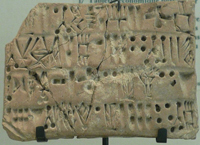- Introduction
- Further information

The writing conventionally known as Proto-Elamite was created in Elam for accounting and administrative registration purposes at the end of the fourth millennium BC. It appears to be the expression of an original local writing experimentation. Proto-Elamite was in use between c. 3100/3050 BC and c. 2800 BC. It is not clear whether Proto-Elamite is the direct predecessor of Linear Elamite. The fact that the vast majority of Proto-Elamite inscriptions come from the site of Susa leaves no doubt about the Elamite origin of this writing system. However, the geographical distribution of the inscriptions on the Iranian plateau shows a spread that goes far beyond the historical region of the Elamite state. Proto-Elamite is documented in Susa, Tal-i Ghasir, Tepe Sialk, Tepe Yahya, Tal-i Malyan, Shahr-i Sokhta, Tepe Sofalin and Tepe Ozbaki. It is assumed that the language recorded by this script is an ancient form of Elamite. This writing remains undeciphered to this day. Not unlike the Proto-cuneiform system that will give rise to the subsequent cuneiform writing system, Proto-Elamite is also configured as a mixed system, formed by signs with logographic value and signs with phonetic value, and in which the signs can have different semantic values. The Proto-Elamite sign inventory comprises about 400-800 characters. At present, approximately more than 1,700 texts in Proto-Elamite are known. The writing was impressed on clay tablets, most of which are of administrative content. The historical relationships between the Proto-Elamite and the Proto-cuneiform systems are not entirely clear. The similarities regarding the number system and the values of the numerical signs would suggest a genetic relationship between the two systems. The presence of graphically similar signs in the two scripts would lead us to suppose that these characters were also semantically similar. Although Proto-cuneiform is believed to be the oldest writing system, both the Proto-cuneiform in southern Mesopotamia and the Proto-Elamite in the Iranian region appear in the same period, c. 3300-3100 BC, perhaps as independent developments from an older common system.
Go to the online resources.
Online resourcesList of symbols
Bibliography
Map of places
